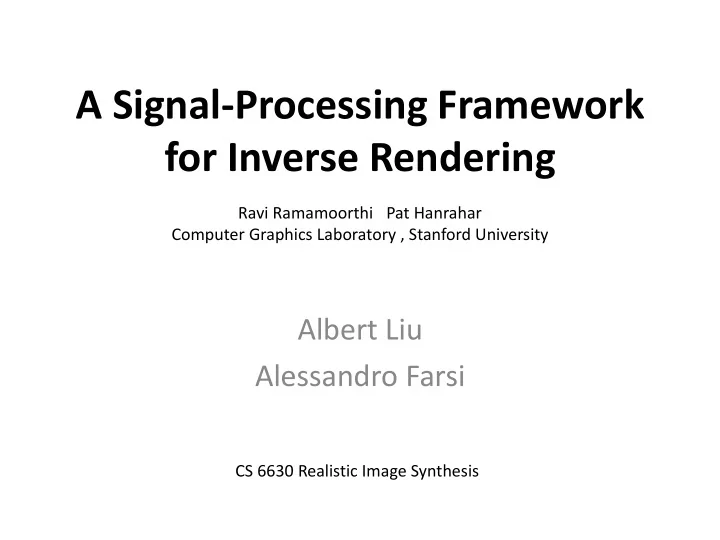

A Signal-Processing Framework for Inverse Rendering Ravi Ramamoorthi Pat Hanrahar Computer Graphics Laboratory , Stanford University Albert Liu Alessandro Farsi CS 6630 Realistic Image Synthesis
Inverse Rendering Inverse Photographs Rendering Algorithm BRDF Lighting Geometric model
Why inverse rendering Precision measurement Data extraction
Signal-Processing Framework • How much information can I extract? • The problem is well- or ill-posed? • What is the best way to express the model? Before only “ handwaving ” explanation
Spherical Harmonics L=0 L=1 L=2 L=3 m=2 m=3 m=0 m=1 m=-2 m=-1 m=-3
Spherical Harmonics Analog to Fourier base for angles 2 l 1 l m m , m cos e im Y l P l 4 l m Coefficients obtained via projection m C l f , , m Y l Orthonormality
Inverse rendering • Known geometry w • Fixed ‘far’ light w ’ • Reflection B L ' ', (a,b) B , , L R , ' ', ' Looks like convolution (and convolution simple in Fourier’s space)
Inverse Rendering • Plugging in SH m R , m p , r p r B , , L l Y l ' Y q ' Y s q , s • Rotation in SH l R , l m l Y m D m , m ' Y m ' • Symmetry in BRDF p , r p q , s q , s
Inverse Rendering • Reflection expanded in SH base l , m C p , q l , m l l l , m B p , q B , , , , l L m C p , q , , p , q BRDF l l l , m l L m B p , q p , q Normalization Reflection (measured) Lightings
Mirror BRDF
Single directional source
Lambertian BRDF
Lambertian BRDF
Phong BRDF
Phong BRDF
Microfacet BRDF
Decomposition of Lights for Microfacets
BRDF Recovery
From Complex Geometry
Questions?
Recommend
More recommend